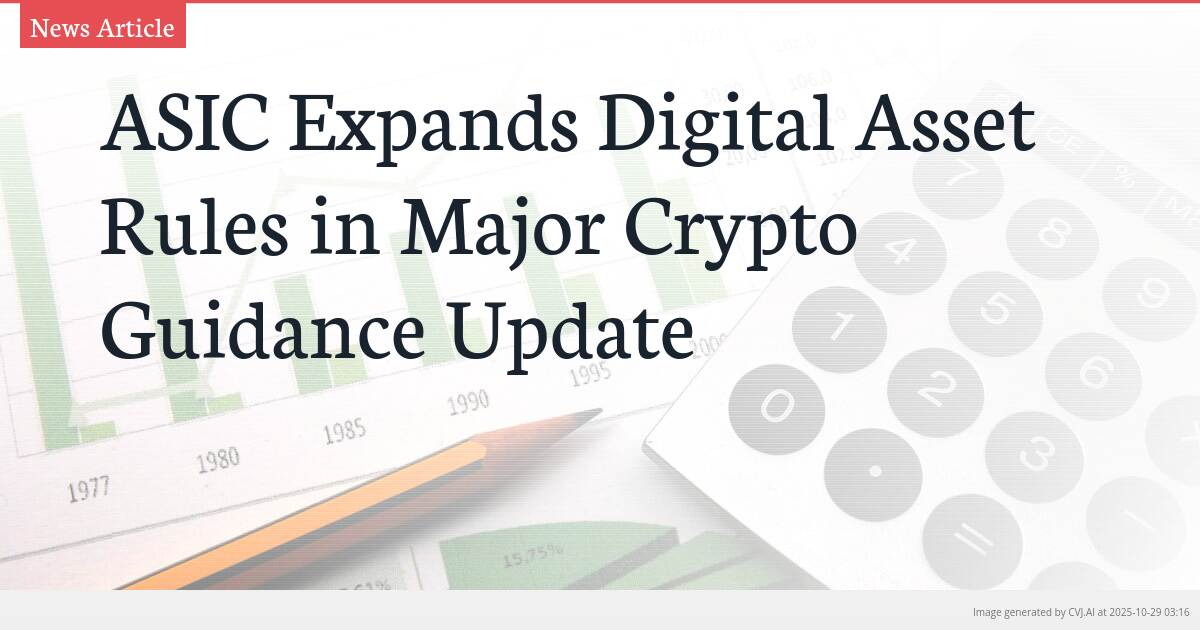This summary text is fully AI-generated and may therefore contain errors or be incomplete.
Introduction
Australia’s financial regulator has significantly updated its digital asset guidance, clarifying how existing financial services laws apply to cryptocurrencies and tokenized products. The revised framework introduces new custodial standards and expands classification examples while confirming that Australian law applies to offshore platforms serving local users.
Key Points
- Introduces new custodial standards requiring firms to maintain up to $10 million in net tangible assets for holding client digital assets
- Expands from 13 to 18 classification examples covering exchange tokens, gaming NFTs, yield-bearing stablecoins, and staking services
- Confirms Australian financial laws apply to offshore and decentralized platforms if they serve local users, regardless of geographic location
Broadening the Regulatory Scope
The Australian Securities and Investments Commission has fundamentally reshaped its approach to digital asset regulation through a comprehensive update to Info Sheet 225. The guidance replaces previous “crypto-asset” terminology with the broader “digital assets” classification, intentionally capturing virtual, tokenized, and coin-based products without exclusion. This semantic shift reflects ASIC’s recognition that the digital asset ecosystem extends far beyond cryptocurrencies to include stablecoins, staking programs, wrapped tokens, and various tokenized products.
The regulator has expanded its classification framework from 13 to 18 worked examples, providing clearer guidance on when digital assets constitute financial products under the Corporations Act. These examples span exchange-issued tokens, gaming NFTs, yield-bearing stablecoins, wrapped tokens, and staking-as-a-service platforms. For each category, ASIC examines whether the asset qualifies as a managed investment scheme, derivative, or non-cash payment facility based on its specific rights and benefits. This expanded framework gives businesses greater certainty in navigating existing financial services laws while Treasury prepares its comprehensive digital asset legislation.
New Custodial and Licensing Requirements
ASIC has introduced stringent new custodial obligations that will significantly impact how firms handle client digital assets. The guidance requires entities holding client assets to meet net tangible asset thresholds of up to $10 million (approximately US$6.5 million), unless their custody role is deemed incidental to their primary business operations. This capital requirement represents a substantial commitment for digital asset platforms and custodians, reflecting ASIC’s focus on ensuring adequate financial backing for firms handling client funds.
The regulator reiterated that many digital assets, including yield-bearing tokens, staking programs, and asset-referenced stablecoins, will likely require an Australian Financial Services license under current law. ASIC also reinforced that Australian financial services laws apply to offshore and decentralized structures if they are marketed or sold to local users, warning that global platforms cannot rely on geographic distance to avoid domestic oversight. This position ensures that international platforms serving Australian consumers must comply with the same regulatory standards as domestic operators.
In a concession to market realities, ASIC outlined transitional measures allowing experienced crypto professionals to qualify as responsible managers under AFS license requirements. The regulator also signaled possible no-action relief for firms actively seeking authorization, providing a practical pathway for existing market participants to achieve compliance without immediate regulatory action.
Alignment with Broader Regulatory Framework
The updated guidance aligns closely with Treasury’s forthcoming Digital Asset Platforms and Payment Service Providers bills, which will introduce formal licensing regimes for exchanges, custody platforms, and certain stablecoin issuers. ASIC explicitly stated that its framework will evolve alongside these Treasury reforms, creating a coordinated regulatory approach across government agencies. This alignment ensures that businesses receive consistent guidance as Australia’s digital asset regulatory landscape matures.
The update builds on ASIC’s September decision to grant class relief to intermediaries distributing stablecoins from licensed issuers. This exemption allows stablecoins issued by licensed entities to be distributed without secondary-market or clearing licenses, provided that issuers remain responsible for disclosure and compliance. This pragmatic approach creates a bridge while Treasury finalizes its comprehensive stablecoin regime, balancing market development with consumer protection.
ASIC acknowledged the complex regulatory overlap with other agencies including AUSTRAC, APRA, the ATO, the ACCC, and the Reserve Bank of Australia, underscoring its role within a broader regulatory network. The regulator also introduced specific guidance for fund managers and exchange-traded product issuers offering retail exposure to digital assets, setting expectations around custody, risk management, and disclosure under Chapter 5C of the Corporations Act.
Market Implications and Industry Response
The guidance arrives as the Labor government advances its digital-asset-platform legislation, expected to introduce formal licensing for exchanges and custodians later this year. Industry participants have welcomed the increased clarity while recognizing the compliance challenges ahead. A spokesperson for Australian crypto exchange Swyftx told Decrypt that “the government has said it wants Australia to be a leader in digital assets, but it’s all about balancing consumer protections and innovation. We don’t want to end up with a big value transfer away from local consumers and businesses to offshore providers.”
ASIC notably stopped short of defining “true DeFi,” indicating that whether participants in decentralized-finance arrangements require licensing will depend on individual facts and roles. This case-by-case approach provides flexibility for innovative DeFi structures while maintaining regulatory oversight where appropriate. The guidance emphasizes that while the framework doesn’t create new law, it provides essential interpretation of how existing financial services laws apply to the rapidly evolving digital asset sector.
The comprehensive update represents Australia’s most significant step toward establishing a clear regulatory framework for digital assets since ASIC began engaging with the sector. By providing detailed guidance ahead of formal legislation, ASIC enables businesses to prepare for compliance while supporting the government’s ambition to position Australia as a leader in the responsible development of digital asset markets.
📎 Read the original article on decrypt.co

